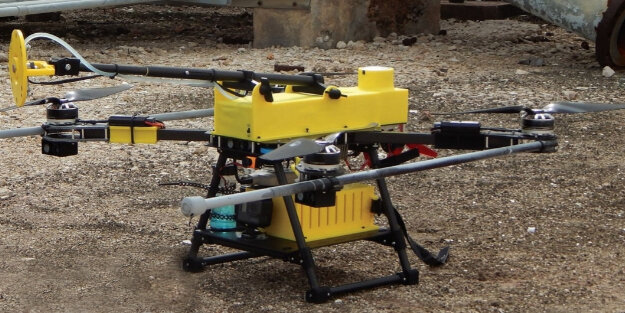Drones Being Used for Ultrasonic Testing (UT) on Energy Assets
/When a tall asset requires non-destructive testing (NDT) in the form of ultrasonic thickness measurement, it used to require a human and lifts, scaffolding, ladders, elevated baskets, catwalks, or other solutions. But now, drones are being deployed with ultrasonic testing (UT) devices to save humans from the height.
From ME Feature
UT thickness measurements are used, just as the term implies, to test the thickness of assets, especially when access is only available on one side. It’s often used on storage tanks, flare stacks, wind turbine towers, and more.
The goal of NDT processes like UT is to inspect assets, capture data, and identify potential problems while an asset is still up and running. Issues identified through NDT can be handled with less downtime, less disruption, and less risk.
Using drones for UT thickness measurement is a unique application for unmanned aerial vehicles (UAVs). While drones are widespread for visual inspection, they are not used as frequently for contact-based inspections like UT.
Advanced technology is required to make the contact-based inspections happen. Manual control can’t accomplish the precise flying and maneuvering required, so software control is vital.
The drones are also equipped with HD video capture. Videos and photos, along with all the other data collected from the inspection, are transferred so the engineers can review and report on findings. Tech like AI, machine learning, data visualization, cloud computing, AR/VR, 5G, and more can be used to make the most of the data that’s collected.
Drone UT inspections improve safety, can lower per-inspection cost, and reduce the time required to complete an inspection. In an example use case, profiled in Materials Evaluation, a company completed UT measurements at more than 100 locations in under 90 minutes, including multiple readings per location and battery swaps.
Many drone providers are creating solutions for UT measurement.
Apellix does UT measurement with precision flight and advanced sensors.
Eddyfi Technologies helps pipeline operators inspect assets with many types of drones and measurement tools.
Gecko Robotics uses UT as one of its many inspection methods.
Mitras uses robots to do NDT on large structures using robotics, automation, and data.
Terra Inspectioneering and Skyline Drone use drones to inspect confined and hazardous energy assets with UT, visual, and other inspection methods.
Skyguage Robotics is working to make drone UT and visual inspections safer, faster, and more data-driven.
Drones may not be the right solution in every UT situation. High winds, rain, and other weather can keep drones on the ground, and the drones can’t adapt to unexpected situations.
But if drone UT inspections do make sense, they can provide safer work environments, create better data to manage assets, and unlock cost savings. With this, engineers and inspectors can spend time on higher-value activities that come with industrial asset operation and maintenance.
Drones and energy assets...they’re thick as thieves.



